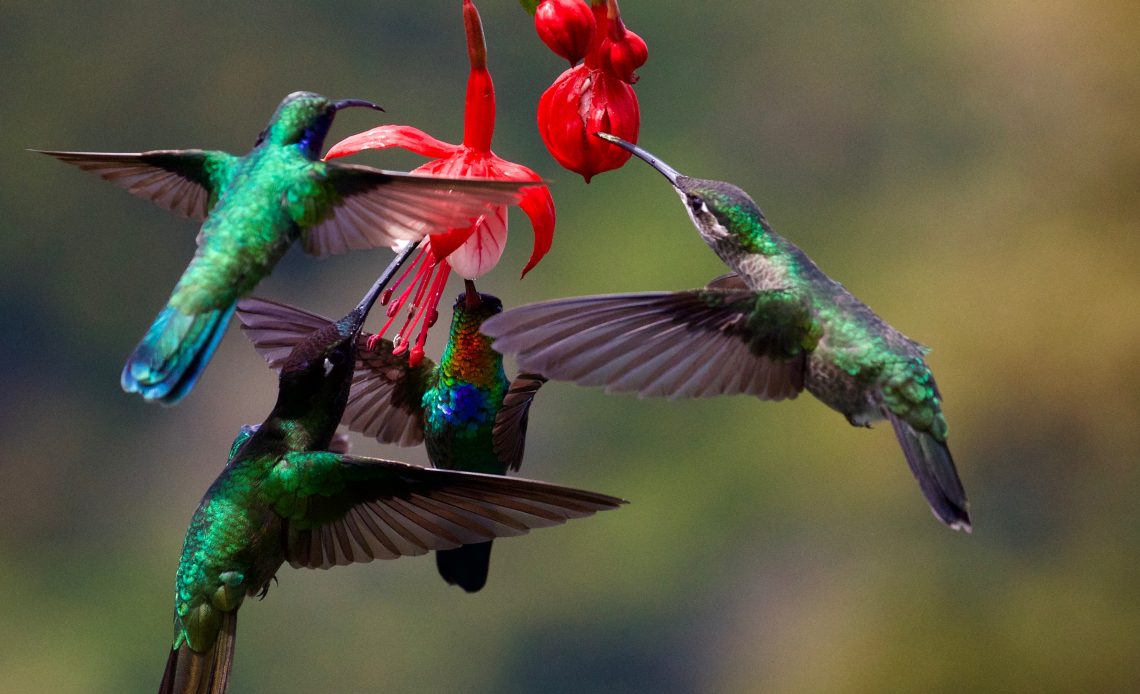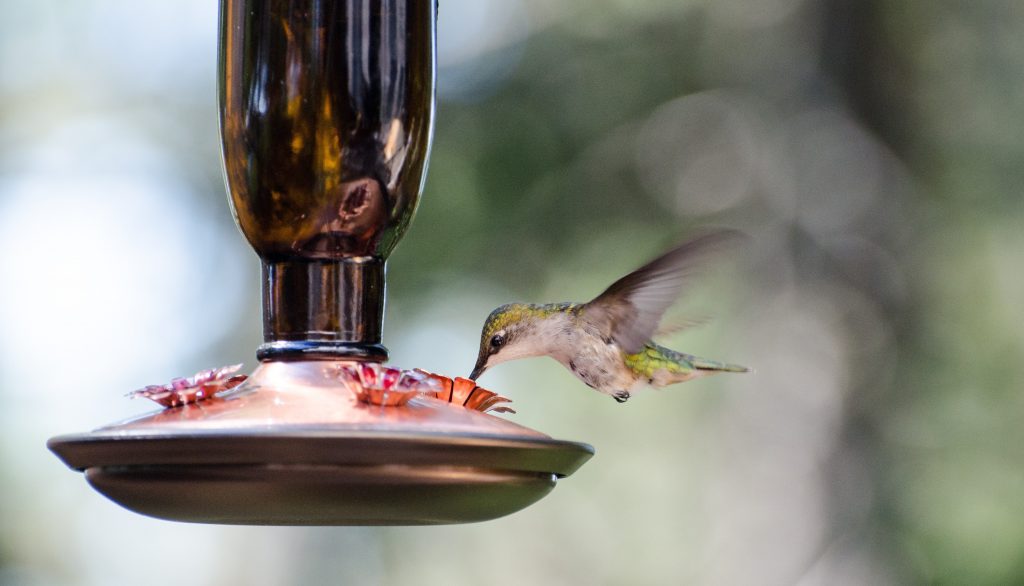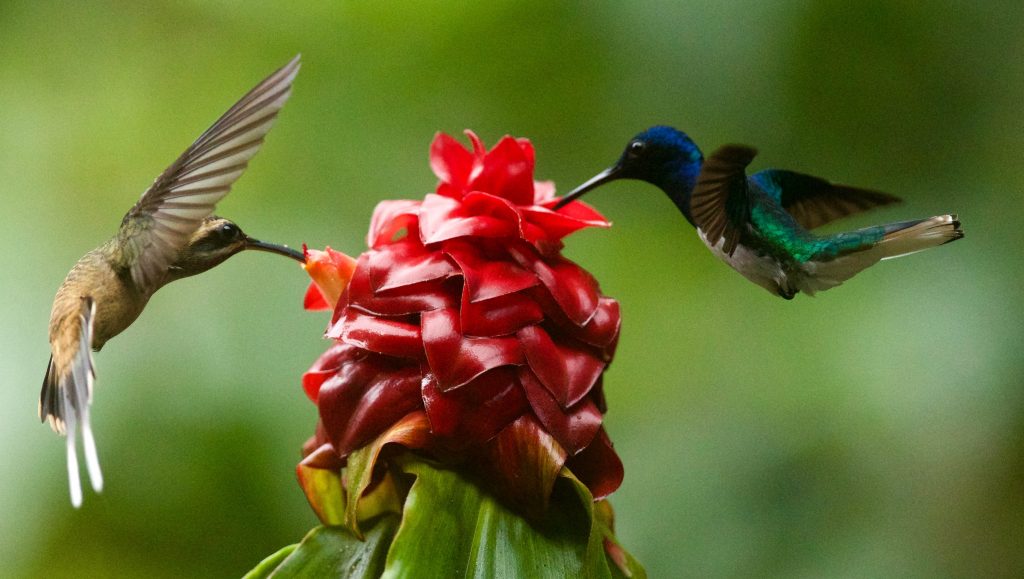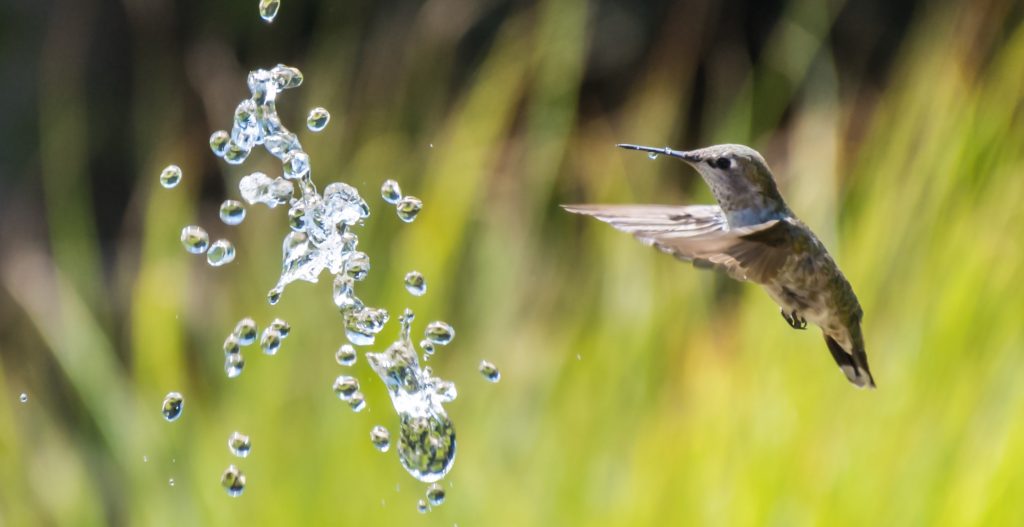

We’re here to help! Wild Yards is a completely free website that is 100% dedicated to helping you create a wildlife-friendly, sustainable yard. Read more
WildYards is reader-supported. When you buy a product through a link on our site, we may earn a comission. Every product is independently selected by our (obsessive) editors and our reviews are unbiased and objective. Read more about our mission or our privacy policy.
If you’ve never seen a dedicated hummingbird garden in person, then you’re really missing out.
Being surrounded by tons of hummers zipping through the air, going from flower to flower is an amazing experience. Unfortunately, attracting lots of hummingbirds to your yard is not as simple as putting up a hummingbird feeder or two. Creating a hummingbird haven requires careful planning and lots of patience.
Fortunately, we’ve talked to many experts and done our own research on how to attract hummingbirds to your yard and today you get to learn from our experiences.
Here are six ways you can spruce up your yard to make it as inviting as possible for hummingbirds.
How To Attract Hummingbirds To Feeders

If you want to attract lots of hummingbirds, the easiest way to do so is to buy the best hummingbird feeder. Actually, you should buy a few of them. We’ll tell you why later.
Hummingbirds have to feed every 15 minutes to keep up with their active lifestyle. So it’s no wonder that hummingbird feeders are so effective in attracting them.
One of the biggest issues that people have is that they buy a hummingbird feeder, hang it, and expect swarms of hummingbirds only to be disappointed when none show up.
Here are a few tips to attract hummingbirds to your feeders.
Buy the Best Hummingbird Feeder
There’s not much you can do if you buy a low-quality and ineffective feeder. Finding the right feeder for your backyard is not an easy task which is why we wrote an entire guide on hummingbird feeders that you should read if you haven’t purchased one yet.
But to summarize that post, you should look for a feeder that has perches, is red-colored, and has some kind of protection from ants and bees. All three of those factors will increase the chances that hummingbirds will enjoy visiting your feeder and return daily for that sweet nectar.
Use the Best Nectar
Talking about nectar, you shouldn’t neglect the food itself.
Hummingbirds will refuse to drink spoiled nectar so making sure that your nectar is nice and sweet and replacing it before it spoils is very important. Nectar usually lasts around five days or so, less if it’s really hot outside. When it spoils, nectar will turn cloudy. That is a good guideline on when you should replace it.
The nectar quality itself is also important. The easiest (and cheapest) way to guarantee quality nectar is to make it yourself. This nectar recipe is our favorite by far. Just make sure you don’t follow the bad advice of adding red food coloring to your nectar. Some studies suggest that it can cause health issues for hummingbirds. Plus, if your feeder is already red, that is good enough.
If you want to increase the time before your nectar spoils, check out Nectar Defender. They claim that adding their product to your homemade nectar increases its lifespan to weeks instead of days.
Where to Hang Your Hummingbird Feeder
A hummingbird feeder is useless if the hummers can’t find it. Where to hang a hummingbird feeder is one of the most asked questions about feeders.
Here are a few tips on finding the best location in your yard to hang a hummingbird feeder:
- Place your feeder close to shelter or places for the hummingbirds to perch. This will make them feel safe from predators.
- Place it where hummingbirds are already visiting. If you have a bunch of colorful flowers that are attracting hummingbirds already, it’s a good idea to place the feeder nearby.
- Place the feeder in partial shade. Direct sunlight all day long will make your nectar spoil at a faster rate than in the shade. But the sun shining and reflecting off the nectar and the red feeder will catch the eye of hummingbirds flying past. So try and get the best of both worlds and play it in a semi-shady area.
- But don’t forget about yourself either. Place your feeders somewhere where you can enjoy the view!
Keep your Feeders Clean & Maintained
Hummingbirds like a well-maintained and clean feeder. Here’s a great guide on how to clean a hummingbird feeder and keeping it fresh.
Squash the Bullies
Earlier we mentioned that you should buy multiple feeders. Not only will that attract more hummingbirds to your yard, but it will also prevent any bully hummingbirds from monopolizing a single feeder.
Hummingbirds can be territorial and quite often you’ll see a single hummingbird protecting a feeder (their source of food) from other hummingbirds. But if you have multiple feeders, a single hummingbird won’t be able to keep the other hummingbirds away from them all.
Plant Flowers that Attract Hummingbirds

Feeders aren’t the only way to attract hummingbirds to your garden. The original feeder is the flower. By planting flowers designed to attract hummingbirds, you’re not only giving hummingbirds another source of food but also increasing the chances that a hummingbird flying by will stop at your yard. Plus, hummingbird flowers tend to be bright and colorful which is attractive to us also.
Here are some things to consider while growing your hummingbird garden.
Keep it Local and Native
Hummingbirds instinctively know what flowers and plants provide nectar and which don’t. They prefer plants that are native to the area, so keep that in mind when planning your garden. It’s also better for your local ecosystem and bee population.
Native plants don’t just provide a source of nectar for hummingbirds, they also attract insects which hummingbirds eat for protein.
Some of the best flowers to attract hummingbirds are native plants like the trump honeysuckle, bee balm, and hummingbird sage. The Audubon society has a great tool you can use to figure out what plants are native to your area.
The best flowers to attract hummingbirds are:
- Coral Honeysuckle
- Bee Balm
- Sages
- Cardinal Flower
Most of those flowers have a variant that is native to most parts of the United States.
Try to Have Continuous Blooming
By having a variety of flowers with different blooming periods, hummingbirds will always have a reason to visit your yard.
The best way to do this is to visit a local garden center and ask for help in creating the perfect hummingbird garden. They’ll know the blooming periods of all native flowers and which flowers require what conditions. When we consulted a garden expert they told us to consider something like a basket of fuchsia for the spring, a salvia variant for the summer, and a trumpet creeper plant for the fall.
Having a blooming flower in the late season (late summer and fall) is especially important because that’s when flower production is down but hummingbird numbers are high.
Deadhead your flowers
This is an old trick that works wonders for enhancing the blooming periods of your flowers which results in more hummingbirds.
“Deadheading” refers to the removal of blossoms and seed heads shortly after they have wilted. This tricks the plant into creating more flowers and seed heads, extending their bloom time. Just make sure that towards the end of the season, you stop deadheading to ensure that the flower will come back next year if it’s a perennial.
Here’s a great video guide on how to deadhead flowers:
Avoid Using Pesticides
As we mentioned earlier, hummingbirds eat insects to get their fill of protein. If you use pesticide in your garden, you’re killing off an important part of a hummingbird’s diet.
Provide a Source of Water

Hummingbirds, like other types of birds, require water to clean themselves and to drink. Having a source of water, like a great birdbath, is a foolproof way to attract all types of birds.
However, if you specifically want to attract hummingbirds, the secret is to get a mister, like this one. A mister does exactly what it sounds like it does – shoots a fine mist of water into the air. The hummingbirds will fly back and forth through the mist until they’re soaked and then fly off to perch somewhere while it preens itself.
A hummingbird will also use a bubbler or a fountain created by a solar birdbath pump to clean itself or drink. The key is to have moving water – the sound and visual movement attracts hummingbirds and other birds.
Help Hummingbirds Find A Nesting Place
Having a backyard with plenty of sources of nectar will increase the chances of a hummingbird deciding to build a nest nearby. If that happens, it’s a great opportunity to observe the full cycle of a hummingbird’s life. Plus, baby hummingbirds are adorable.
Want to increase the chances of a nesting hummingbird in your yard?
Here’s a few tips on how to make your backyard baby hummingbird friendly:
- Don’t remove old spiderwebs. Interestingly enough, hummingbirds use spiderwebs to construct their miniature nests and hold everything together. Maybe it’s time to get over your fear of spiders, huh?
- Plant some shrubbery or small deciduous trees. Hummingbirds, like all other animals, like to raise their young in a sheltered area. Dense shrubbery and deciduous trees are favorite hiding places for hummingbirds, so make sure you have some on the outskirts of your yard if you don’t already.
- Move the feeders further away from potential nesting spots. While hummingbirds like to nest close to sources of nectars, they won’t nest in a shrub if it’s also only a few feet away from a feeder. That attracts way too much unwanted attention. It’s best to move the feeders a decent distance away from any shrub or tree you would like a hummingbird to use as a nest.
Give Hummingbirds a Few Resting Perches
It feels like hummingbirds are always on the move, zipping from one flower to the next. For the most part they do, since they have to feed so often. But they do enjoy moments of rest and relaxation in between their food runs. These times are great for us to observe them without feeling dizzy from trying to follow them with our binoculars.
Hummingbirds prefer to take a break in sheltered areas like dense shrubbery and trees. If your yard doesn’t have these elements in them, you should plant some native shrubs. Bonus points if it produces nectar.
Conclusion: Creating a Hummingbird Garden
While some of the tips in this articles on how to attract hummingbirds to your yard are more intensive than others, trust us when we say that it’s worth it in the end.
Cultivating a hummingbird garden and having twenty or more hummingbirds flying around is an amazing experience and not one you should miss out on.
Did we miss anything? Do you have any questions? We’d love to hear from you in our comment section below.

Black chinned hummingbird female gone in early August why.